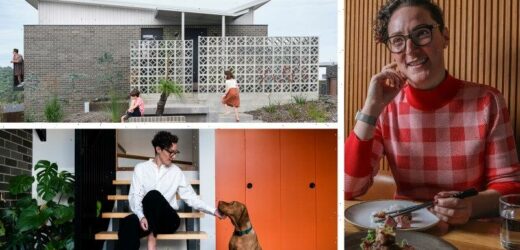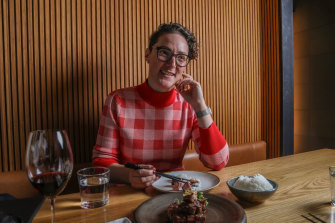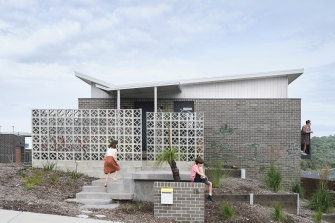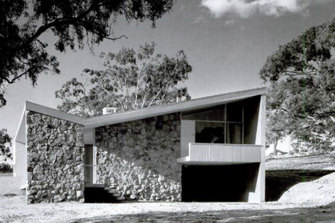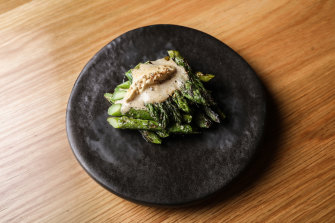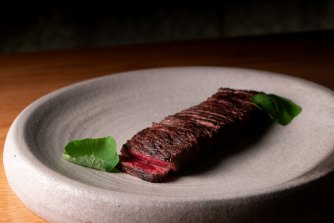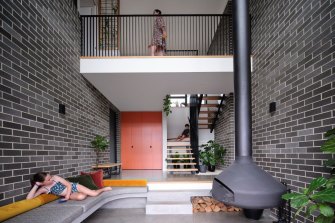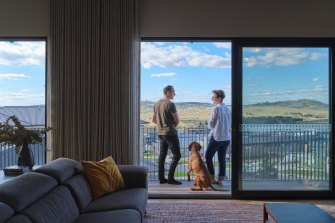By Julie Power
Battisson inside her aware-winning home.Credit:Rhett Wyman
Shannon Demicoli Battisson loves overhearing locals who stop to talk about her home on evening walks in her new suburb.
“They ask, ‘Why does it face such a funny angle? Why are there weeds in the driveway? Why is the roof upside down?’,” says Battisson, the newest national president of the Australian Institute of Architects.
(The answers to this pop quiz are at the end of this article.)
Australia has about 13,000 architects. Yet fewer than 6 per cent of homes are designed by them. Few architects are involved in high-volume housing projects, and they are largely absent from new suburbs and affordable housing.
Battisson is determined to change this, and make her profession more relevant. “I want to smash the image that architecture is only for the elite.”
She leads by example, by living and building affordable and sustainable homes for ordinary people in the suburbs of Canberra.
Shannon Battison, the new national president of the Institute of Architects, has plenty to say.Credit:Zachary Griffith
There will always be a place for “incredibly bespoke whimsical, you know, magical, architectural houses”, she says. But there is equally a place for architects in the affordable housing market.
“It’s really easy to forget that those buildings that we’re building now should stand for 50-odd years before they need renovating. If we don’t get them right, then we’re setting up multiple generations to live in really bad quality [homes]. As the climate is showing us, it is too high a cost not to get it right before we build.”
As she puts it, those people who most need well-designed homes to manage rocketing energy bills and keep the climate at bay are least likely to get them.
When we meet for lunch on a windy cold Monday in Canberra, she is elated and tired after two weeks of speeches marking the start of her two-year presidency.
At the ceremony, she was garlanded with a silver chain of office designed in 1964 by the Opera House’s architect, Jorn Utzon. Pressure much?
Three days before lunch, Battisson and her practice, The Mill: Architecture + Design, had been awarded 2022’s highest award for sustainable architecture from the ACT chapter of the Australian Institute of Architects.
It was for her home, The House with Old Roots, built in Denman Prospect, a greenfield suburb in Canberra’s Molonglo Valley currently being developed.
There are not many trees growing there yet. Her home in this new suburb got its name and some history from the transplantation of a much loved magnolia tree from the Battisson family’s first home, built by her husband’s grandparents.
The jury said her new home showed sustainable architecture didn’t have to be costly, and could be beautifully integrated in a comfy family home.
Shannon Battisson’s home in Denman Prospect. Credit:Anne Stroud
Only 41, and the second-youngest national president ever, it was Battisson’s third big architecture award, including the ACT President’s Medal in 2017 and the shared prize of Emerging Architect in 2018.
To be honest, this interview with Battisson, didn’t only take place over lunch at the Japanese restaurant Raku in Canberra.
It started months before over coffee, and continued in phone calls, the last before she flew out to the United States in June for a month of conferences, vacation and to visit her favourite place, Palm Springs. It is the home of mid-century modernism with houses by A. Quincy Jones, Albert Frey, Herbert W. Burns – many with an upside-down butterfly roof like Battisson’s.
She was born in Sydney’s inner west to “awesome humans”. Her Maltese mother Julie Demicoli and Australian dad, the late Rob Anderson, were strong unionists, who also advocated for refugees, women and the environment. They taught her to have strong opinions, and to be “prepared to fight for [them]“. She has a lot to say, and already she has come out swinging on:
- House sizes: too big, too close to others, poorly insulated, and too reliant on air conditioning/heating. “It is unbelievable that up to 40 people die in Canberra every year because their homes are too cold,” she says.
- The environment – it is time for architects to lead on environmental issues, she says. Residential buildings represent 12 per cent of carbon emissions and 24 per cent of electricity use.
- Improving existing housing – Battisson is calling on the government to provide incentives for owners of existing housing stock – often described as tents with windows – to better insulate their homes.
Hary Seidler’s Bowden House in Canberra has a butterfly roof.Credit:National Archives of Australia
- The Palm Springs of Australia: “Australians love to kind of rag on Canberra, but actually, we have an incredible percentage of unforgettable mid-century architecture.” This includes Bowden House by Harry Seidler, Roy Grounds’ Academy of Science dome, and homes by Robin Boyd.
Over lunch, she gives great chat. She doesn’t like the smell of fish, a challenge for her growing up in a family of fish-loving Maltese migrants.
That makes Raku, which does a roaring trade in sushi and sashimi, a curious choice for lunch. As we arrive, hulking bits of octopus sizzle on the grill.
But Battisson likes Raku’s service and its beef. She was also touched when its chefs made her a special fish dish to see if they could fix her aversion.
Given these restrictions, I suggest she pick. She chooses the eggplant miso soup to start, followed by the 150-day grain fed Scotch fillet with three sauces, rice, some asparagus and spicy corn.
I muck up the order. But the miso, minus the eggplant, which I failed to request, is warming.
She picks at the Scotch fillet, saying she is a grazer who eats small amounts rather than a wolfer-downer like me. Bad luck for her; the fillet is delicious.
The asparagus at Raku in Canberra.Credit: Zachary Griffith
The local red wine, a Sangiovese from Collector, is so good that it sends me Googling to buy some later.
The corn is perfectly charred and a bit sticky, enough to have awkward moments where kernels get stuck in my teeth.
If she notices, she is too polite to say anything. That could be the legacy of her time working as a customer service officer at Qantas during her two-year gap period and later in university holidays.
Her late dad was a Qantas baggage handler. She handled people.
“There is nothing like having a big-name politician swear and lose their temper at you,” she said. As the new president, she is determined to be apolitical, and refuses to name and shame the pollie.
“I was 18, and to have somebody screaming at you for whatever reason, that they’ve missed their flight or their bags were too heavy or whatever, it was really good training.”
Qantas’ staff discounts also underwrote five overseas trips, including to Pakistan, a trip that solidified her “love of people and how people live and build”.
She recalls being invited for tea by a local family in Peshawar, on Pakistan’s north-west frontier, on a “breathtakingly hot day”.
“We walked through a beautiful series of courtyards, and they were by no means wealthy, into a space where we were allowed to take our headdress off, sit and have tea. It was so much cooler. There’s nothing more generous than somebody welcoming you into their home. That experience around the world has taught me the most wonderful things.”
The beef at Raku, Canberra, is delicious.Credit:Zachary Griffith
Despite being endlessly fascinated by how other people lived, Battisson didn’t always want to be an architect. She’d intended to study medicine after school but had deferred.
When she returned from yet another trip, her mother stated the obvious. “Mum noted that I only ever took photos of buildings,” says Battisson. “She said, ‘Maybe you should study architecture and get it out of your system, and then I could get a photo of you and your sister, you know, in front of a building’.”
“From the moment she said that, I couldn’t get it out of my head,” says Battisson. “I knew suddenly that [architecture] was what I wanted to do.”
Studying architecture at the University of NSW, though, she wasn’t as engaged as other students. Her father had been diagnosed with a terminal illness. He lived with her for much of her degree. Every day she would race home to be with him, caring for him with her sister over the next seven years until he died.
The interior of Shannon Battisson’s house.Credit:Anne Stroud
She is also critical of the way architecture is taught, saying there is insufficient emphasis on problem-solving and responding to clients’ needs.
Her real education in architecture came from architect Laurie Virr, her mentor and friend, who died last year.
He was, she wrote in his obituary, the antithesis of what most people think when they hear the word, architect. His final words to Battisson days before he died were: “Australians just don’t seem to think architecture is for them. How do we enthuse a nation who for the most part have no interest? We must be the flag bearers and fight for the change!”
The home that Virr designed for his family decades ago was modest even by that era’s standards. It was a passive solar dwelling the same size as government housing of the time.
With so few homes designed by architects, a constant theme for Battisson is that suburbs are full of buildings that have little to do with the people who will live there, the Country on which they are located, and the climate they will endure.
The view from Shannon Battisson’s home in Denman Prospect.Credit:Anne Stroud
Battisson says the most powerful thing about her work designing houses in the suburbs is that they start a conversation.
“We can hear [neighbours] out in the street with our windows open in summer, and they stop in the driveway, and they talk about it. That’s the most powerful thing about architecturally designed houses in the suburbs is that it instigates conversations.”
Her windows are open because the House with Old Roots is designed to minimise heating and cooling costs. It uses overhead fans and open windows to cool in summer.
But the gentle sound of her fans whirring is often drowned out by her neighbours’ air-conditioning units “working hard to expel hot air out over hot concrete”. “This is simply unsustainable,” says Battisson.
And the answers to the questions those locals ask? Her house is angled on the block to face north to get the sun, and make the most of the winter sun while shading it from the harsh summer heat. That means it requires less heating and cooling.
The “weeds” in the driveway? They are the Australian native, dichondra, grown to absorb moisture, cool the air and prevent run-off.
Why the upside-down roof? “Because I love a butterfly roof,” she said. “It’s a modernist roof that’s beautiful.”
And the little v-shape of the butterfly roof kicks back prettily to hide the solar panels. A little Palm Springs in Denman Prospect.
Julie Power was a lay juror on the panel deciding the Australian Institute of Architects’ NSW Award for best new home, announced on Friday, July 1.
Our Breaking News Alert will notify you of significant breaking news when it happens. Get it here.
Most Viewed in National
Source: Read Full Article
